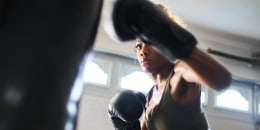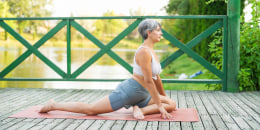Reformer Pilates is a notoriously difficult version of the exercise that's already know to be one of the toughest workouts out there. In fact, when TODAY's Craig Melvin tried reformer Pilates, it called it “perhaps the most intense” he’d ever done, adding that it left him sore for three days afterward.
Pilates, named after founder Joseph Pilates, is all about exercises to strengthen and tone your core, as well as your arms and legs. You work your midsection through repeated movements, which can be especially beneficial for people with back problems. While going through the Pilates exercises, typically performed on a mat, you’re encouraged to focus on your technique and breathing.
Reformer Pilates is a slightly different take, performed on a reformer machine rather than a mat, and it can be particularly helpful for people who’ve recently had an injury or want to get more precise with their movements in order to isolate and strengthen certain muscles.
As a certified Pilates instructor, I usually recommend newcomers to Pilates try a mat class first. Performing the exercises on a mat gives you the space and time to get used to the movements without having to worry about using a machine. Then, you might consider trying wall Pilates for added resistance with moves that resemble those done on the reformer before hopping onto a machine. But for people who want to jump right in and try a reformer, here’s what you need to know about how the machine and reformer classes.
What is a Pilates reformer?
A reformer machine looks like a bed frame with long, stretchy springs attached at one end. Instead of a mattress, the frame has a platform on wheels that rolls back and forth as you perform the moves.
The springs provide resistance, which helps to lengthen and strengthen your muscles. The workout teaches you to focus on belly breathing, also called diaphragmatic breathing, and boosts “postural control,” Julie O’Connell, physical therapist at Athletico Physical Therapy, tells TODAY.com.
Reformer classes typically cost between $25-45.
Parts of the Pilates reformer machine
The reformer machine is completely adjustable, so you can modify your exercises and resistance according to your fitness level. A reformer class can be just as useful for someone looking to intensely work their core as it is for someone recovering from an injury.
The reformer has a bar at one end, which is adjustable. Depending on the exercise, you may place your hands or feet on the bar. On the opposite side, there’s a set of long straps with handles. For certain moves, you loop your feet through the handles and use the straps as you extend your legs.
The platform part of the machine is also known as the carriage. It’s connected to the end of the frame by the springs, and the springs create your chosen level of resistance. You use your body weight and muscles to push and pull the carriage along the reformer’s frame. Blocks on the carriage that rest above your shoulders can help ensure you don’t slide off the carriage as you work out.
Is the Pilates reformer a good workout for you?
People of all fitness levels can get a safe but challenging workout with the Pilates reformer, Paula Lester, manager of the Pilates studio at Privé-Swiss Fitness, tells TODAY.com. Anyone who wants to strengthen their core and improve their posture can benefit. Since the workout also helps you learn which muscles to engage and when, it can make you a better athlete; lose weight; help you recover from an injury; improve balance, bone density and posture; and reduce back pain, Lester says.
However, it’s important to keep in mind certain limitations of the Pilates reformer so you stay safe when using it. For example, you need to be able to lie down flat on your back without injuring yourself. If you’re pregnant and in your third trimester, it’s not the best workout since it’s not recommended to lie down for an extended timeframe at this stage, O’Connell explains.
Also, if you have significant problems with your spine or neck, you may want to consult your health care provider and be sure you know the correct adjustments to make to certain moves, says O’Connell.
Inform your instructor if you’re at all injured, and don’t hesitate to tell your teacher if you’re in pain from any of the movements so they can help you to adjust the resistance or find a better position.
What results can you expect to see from a Pilates reformer?
The reformer accommodates a full range of motion, which is great for increasing flexibility while building strength. The pushing and pulling with the arms and legs against the resistance of the springs, carriage and body weight makes this a unique strength-building full-body workout that’s different from the regular Pilates exercises performed on the mat. Specifically, when you hold the cables in your hands or put your feet in the cables, you allow your muscles to extend to the fullest position. And while mat Pilates does include some exercises that work the legs and arms, they’re usually done with no resistance unless you’re using light dumbbells, resistance bands or a Pilates ring as an accessory. The reformer is able to target your arms and legs while still focusing on the core, providing a more comprehensive workout.
According to one study, Pilates reformer exercises performed once per week for 10 weeks resulted in reduced fall risk and significant improvements in static and dynamic balance and functional mobility in adults age 65 and older at risk for falling. Another study showed that after twelve sessions of Pilates with the reformer equipment, there were improvements in lower back and shoulder strength.
O’Connell says that you can expect to see increases in flexibility, muscular strength and muscular endurance with an improved mind-body connection. “Visually, you will see strong and lean muscles with improved posture. With the focus on core stability and total body strength, Pilates will help to facilitate muscle activation and development to support proper spinal alignment,” she explains.
I have had a few clients who swear by Pilates reformer workouts. I recommend that they do 2-3 sessions a week to really work on leaning out the body. It’s great for building the smaller core muscles, and also stretching out the longer muscles in the body. In fact, many of my clients see weight loss as a result of their reformer classes and feel that their posture has transformed because of it.
Common Pilates reformer exercises — and how to mimic them at home
Curious what exercises exactly you’ll be performing on the contraption? Here are a few popular Pilates reformer exercises, and ways that you can mimic these exercises on the mat in the comfort of your living room without a reformer machine.
Footwork
Footwork is most often the first exercise done on the reformer. It is done lying down with both feet on the footbar. “This series encourages proper alignment of the hips, pelvis, knees and ankles,” explains Lester. “Since our feet take so much abuse daily just by walking, the footwork series is helpful as it strengthens the muscles of the feet and stabilizes the ankle joint. It can help with pain in the feet including plantar fasciitis,” she adds.
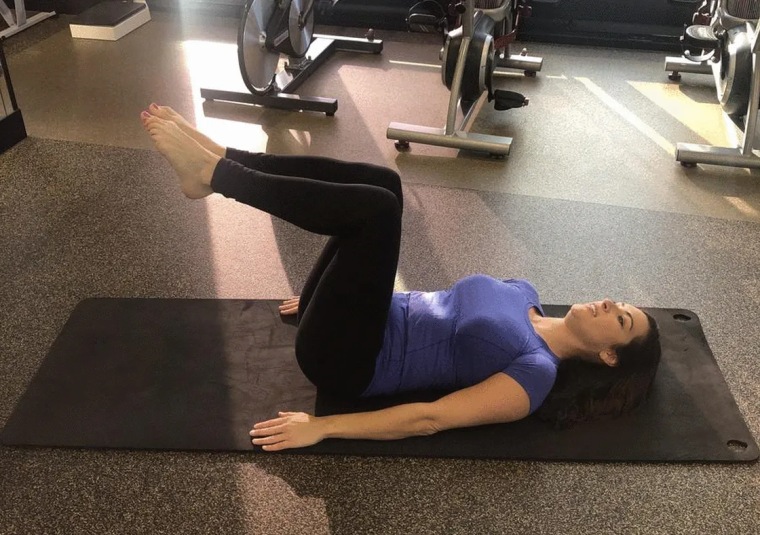
Footwork on the mat
In a mat class, or at home in your living room, you can also practice Pilates footwork. Simply lie down on your back and bend your knees. Pull your navel in toward your spine and bring your knees up to a table-top position. From here, point your toes and press the feet on a diagonal in front of you, and then bring them back to the starting position. Repeat 10 times.
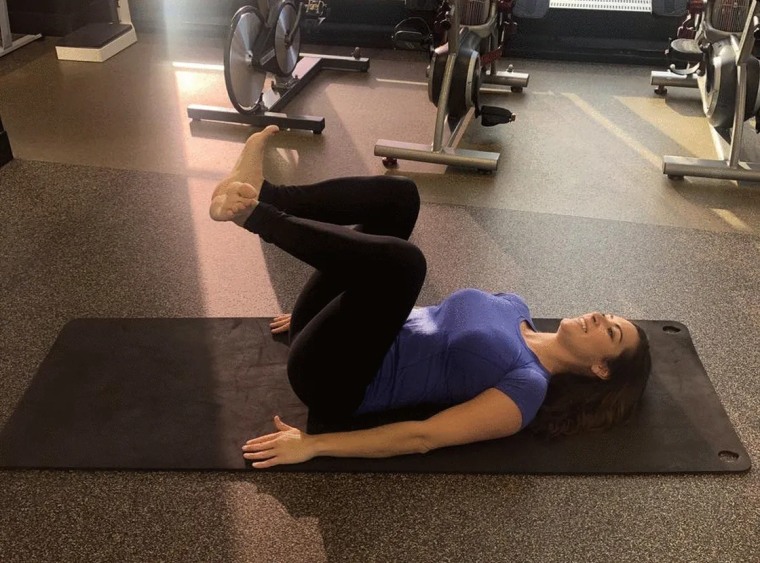
This is a basic move in Pilates footwork, but you can also add on. Instead of doing the movement with pointed toes, you can do it with flexed feet. You can also open the knees as wide as the hips and keep the heels pressed together with the feet flexed. Do each of these variations for 10 repetitions at the beginning of your Pilates Mat routine.
Long stretch
“Long stretch is essentially a moving plank done standing on the reformer holding the footbar and placing both feet on the headrest,” says Lester. This total-body exercise recruits every muscle fiber in the body leading to a stronger core. It helps with joint stability and balance, and strengthens the abdominals, glutes and hamstrings. These support the spine and lengthen the hip flexors, which increase flexibility and improve posture.
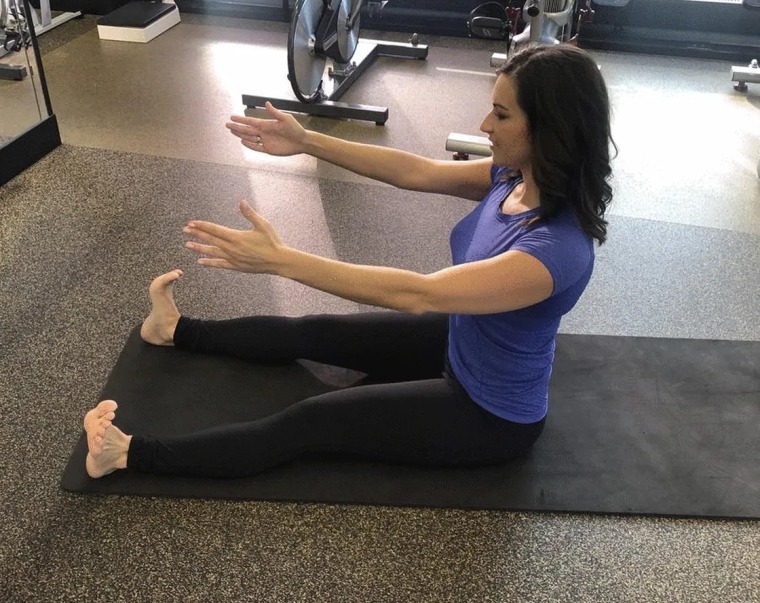
Long stretch on the mat
A close movement to the long stretch is the spine stretch forward on the mat. To do this, sit on your bottom on your mat. Open your legs the width of your shoulders. Pull your navel in toward the spine, and reach the arms out in front of you. Be sure to keep your shoulders back to maintain a straight spine. Then reach forward without moving your legs, and round your spine forward with your head coming in alignment with your outstretched arms. Repeat this 10 times. Breathe in as you come back to center, and breathe out as you reach forward into the spine stretch.
Chest expansion
This exercise works the back of the body while opening up the chest and shoulders and improving posture. “This move is great for those who sit at a desk or drive often,” says Strateman. “Sitting on the long box on top of the reformer with the hands in the loops, place your feet on the headrest with knees bent and arms extended down by the sides of the body,” explains Strateman. “Press through the palms of the hands to extend the shoulders and arms behind the body. Return the arms forward and repeat.”
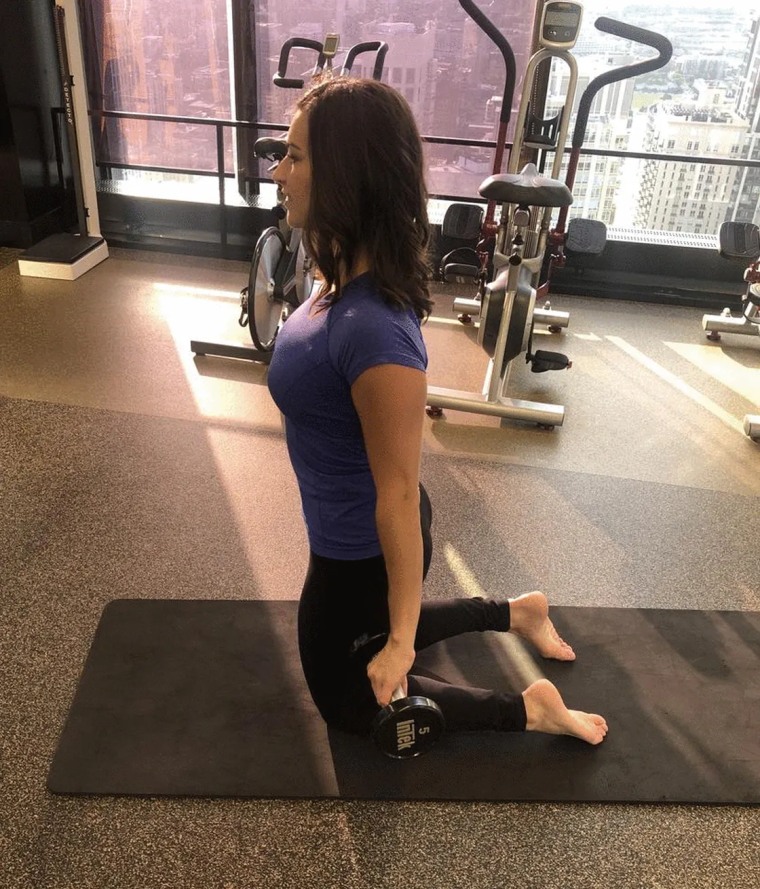
Chest expansion on the mat
For this exercise, you’ll need a pair of light weights that are 2 or 3 lbs. Go onto your mat on your knees, opening them as wide as the hips. Hold the weights down at your sides, and turn the palms toward the back of the room. Pull your navel in toward your spine, and press the weights and arms toward the back of the room. Make sure your chin does not jut forward and that your shoulders do not round up. Exhale as you press back, and inhale as you come to the starting position. Repeat this 10 times.
Side overs
Side overs work the obliques, which are important for a well-rounded, strong core. “It also challenges the body in the ‘frontal plane’ which doesn’t always get worked as often,” says Strateman. To start, sit sideways on the short box on top of the reformer with all of the springs hooked on to keep the carriage stable. “The foot closest to the footbar is in the strap with a flexed ankle, extended knee, and the leg and hip lifted in parallel to the ground keeping tension in the strap the entire time,” instructs Strateman. “The opposite leg is bent resting on the box. Hands are clasped behind the head creating one long diagonal line from head to toe. From there, laterally flex the spine, lowering the torso towards the floor and returning to the start position on the diagonal.”
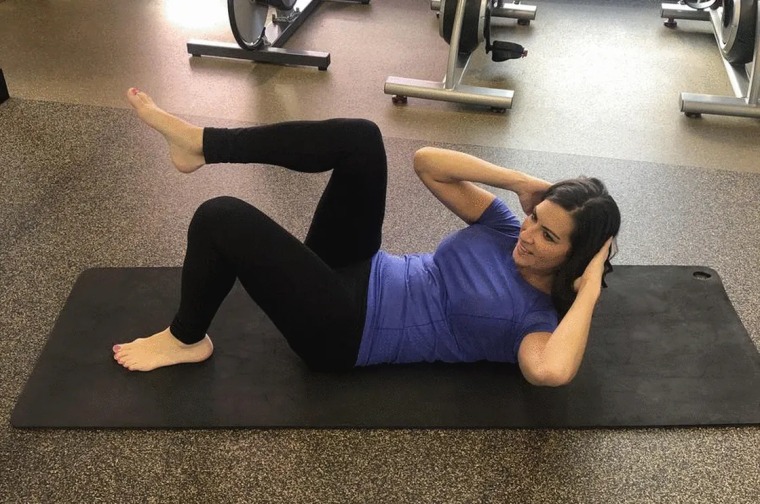
Side overs on the mat
To recruit similar muscles, I recommend performing a side crunch on the mat. This movement will work the obliques and recruits both the upper body and lower body. Lying on your mat, knees bent and feet on the mat as wide as your hips, place your hands behind your head. Tilt your pelvis and engage your low abs as you bring your right knee up to a table-top position. Then curl your head and neck up and crunch your right elbow toward your right knee. Lie your head back down toward the ground as you extend the right leg, keeping your low back pressed into the ground. Repeat this 10 times, and then switch to the left side.
Leg circles
This exercise not only works the core, but the entire hip joint. “Lying on your back on the reformer with both feet in the straps, start with the legs extended long on the diagonal at a 45-degree angle with legs straight and together,” explains Strateman. “Then, lift the legs towards the ceiling just as high as the legs can remain straight with the whole spine from head to tailbone stable on the reformer. Next, separate the legs and continue to complete the circle ending in the starting position.” Repeat this 10 times and then reverse the circles in the other direction.
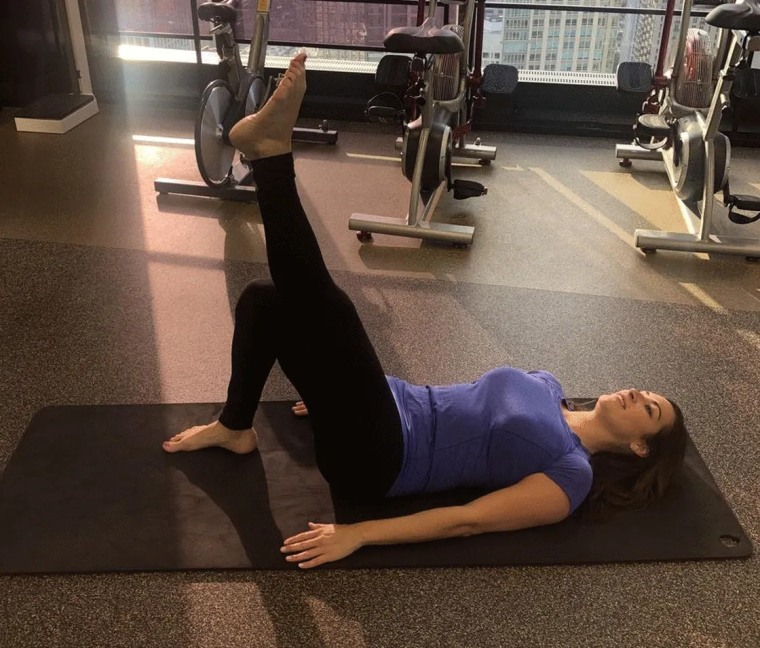
Leg circles on the mat
Lying on your back, pull your navel in toward your spine. Reach the right leg up toward the ceiling. Lower the leg down to 45 degrees. Then open the leg as wide as your right shoulder to draw a circle open, around, and then back up to the starting position. Repeat this 10 times and then reverse the exercise. Then perform on the left leg. To make this more difficult, perform both legs at once. Start with the feet at the ceiling, and then open the legs as wide as the shoulders to make a circle down to the 45-degree angle. Then press the legs together as you draw them up toward the starting position with the legs together. Then reverse the circle.

